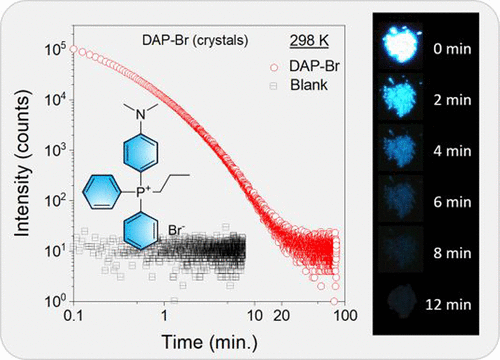当前位置:
X-MOL 学术
›
J. Am. Chem. Soc.
›
论文详情
Our official English website, www.x-mol.net, welcomes your feedback! (Note: you will need to create a separate account there.)
Organic Long-Persistent Luminescence from a Single-Component Aggregate
Journal of the American Chemical Society ( IF 14.4 ) Pub Date : 2022-01-20 , DOI: 10.1021/jacs.1c11480 Parvej Alam 1 , Tsz Shing Cheung 1 , Nelson L C Leung 1 , Jianyu Zhang 1 , Jing Guo 2 , Lili Du 3, 4 , Ryan T K Kwok 5 , Jacky W Y Lam 5 , Zebing Zeng 2 , David Lee Phillips 3 , Herman H Y Sung 1 , Ian D Williams 1 , Ben Zhong Tang 5, 6, 7, 8
Journal of the American Chemical Society ( IF 14.4 ) Pub Date : 2022-01-20 , DOI: 10.1021/jacs.1c11480 Parvej Alam 1 , Tsz Shing Cheung 1 , Nelson L C Leung 1 , Jianyu Zhang 1 , Jing Guo 2 , Lili Du 3, 4 , Ryan T K Kwok 5 , Jacky W Y Lam 5 , Zebing Zeng 2 , David Lee Phillips 3 , Herman H Y Sung 1 , Ian D Williams 1 , Ben Zhong Tang 5, 6, 7, 8
Affiliation

|
Long-persistent luminescence (LPL), also known as afterglow, is a phenomenon in which the material shows long-lasting luminescence after the cessation of the excitation source. The research of LPL continues to attract much interest due to its fundamental nature and its potential in the development of the next generation of functional materials. However, most of the current LPL materials are multicomponent inorganic systems obtained after harsh synthetic procedures and often use rare-earth metals. Recently, metal free organic long-persistent luminescence (OLPL) has gained much interest because it can bypass many of the disadvantages of inorganic systems. To date, the most successful method to generate OLPL systems is to access charge-separated states through binary donor–acceptor exciplex systems. However, it has been reported that the ratios of the binary systems affect OLPL properties, complicating the reproducibility and large-scale production of OLPL materials. Simpler OLPL systems can overcome these issues for the benefit of the development and adoption of OLPL systems. Here, we report on the rational design and synthesis of a single-component OLPL system with detectable afterglow for at least 12 min under ambient conditions. This work exemplifies an easy design principle for new OLPL materials. The investigation of the material provides valuable insights toward the generation of OLPL from a single-component system.
中文翻译:

来自单组分聚集体的有机长效发光
长余辉发光(LPL),又称余辉,是在激发源停止后,材料呈现出持久发光的现象。LPL的研究因其基础性质及其在下一代功能材料开发中的潜力而继续引起人们的广泛关注。然而,目前大多数 LPL 材料都是经过苛刻的合成程序获得的多组分无机体系,并且经常使用稀土金属。最近,无金属有机长效发光 (OLPL) 引起了极大的兴趣,因为它可以绕过无机系统的许多缺点。迄今为止,生成 OLPL 系统最成功的方法是通过二元供体-受体激子系统访问电荷分离状态。然而,据报道,二元系统的比率会影响 OLPL 特性,使 OLPL 材料的再现性和大规模生产变得复杂。更简单的 OLPL 系统可以克服这些问题,从而有利于 OLPL 系统的开发和采用。在这里,我们报告了在环境条件下至少 12 分钟可检测到余辉的单组分 OLPL 系统的合理设计和合成。这项工作体现了新 OLPL 材料的简单设计原则。对材料的研究为从单组件系统生成 OLPL 提供了宝贵的见解。在这里,我们报告了在环境条件下至少 12 分钟可检测到余辉的单组分 OLPL 系统的合理设计和合成。这项工作体现了新 OLPL 材料的简单设计原则。对材料的研究为从单组件系统生成 OLPL 提供了有价值的见解。在这里,我们报告了在环境条件下至少 12 分钟可检测到余辉的单组分 OLPL 系统的合理设计和合成。这项工作体现了新 OLPL 材料的简单设计原则。对材料的研究为从单组件系统生成 OLPL 提供了宝贵的见解。
更新日期:2022-01-20
中文翻译:

来自单组分聚集体的有机长效发光
长余辉发光(LPL),又称余辉,是在激发源停止后,材料呈现出持久发光的现象。LPL的研究因其基础性质及其在下一代功能材料开发中的潜力而继续引起人们的广泛关注。然而,目前大多数 LPL 材料都是经过苛刻的合成程序获得的多组分无机体系,并且经常使用稀土金属。最近,无金属有机长效发光 (OLPL) 引起了极大的兴趣,因为它可以绕过无机系统的许多缺点。迄今为止,生成 OLPL 系统最成功的方法是通过二元供体-受体激子系统访问电荷分离状态。然而,据报道,二元系统的比率会影响 OLPL 特性,使 OLPL 材料的再现性和大规模生产变得复杂。更简单的 OLPL 系统可以克服这些问题,从而有利于 OLPL 系统的开发和采用。在这里,我们报告了在环境条件下至少 12 分钟可检测到余辉的单组分 OLPL 系统的合理设计和合成。这项工作体现了新 OLPL 材料的简单设计原则。对材料的研究为从单组件系统生成 OLPL 提供了宝贵的见解。在这里,我们报告了在环境条件下至少 12 分钟可检测到余辉的单组分 OLPL 系统的合理设计和合成。这项工作体现了新 OLPL 材料的简单设计原则。对材料的研究为从单组件系统生成 OLPL 提供了有价值的见解。在这里,我们报告了在环境条件下至少 12 分钟可检测到余辉的单组分 OLPL 系统的合理设计和合成。这项工作体现了新 OLPL 材料的简单设计原则。对材料的研究为从单组件系统生成 OLPL 提供了宝贵的见解。












































 京公网安备 11010802027423号
京公网安备 11010802027423号